
December 12, 2007
In the dead of night, U.S. war planes obliterated a tent alongside a road in remote Nuristan Province, killing fourteen Afghan road laborers and engineers in their sleep. According to an Associated Press (A.P.) wire service report on November 28, 2007,
"NATO warplanes hunting Taliban fighters in eastern Afghanistan mistakenly bombed an Afghan road construction crew sleeping in tents....If confirmed that NATO hit the wrong target, the incident in mountainous Nuristan province late Monday [November 26, 2007] would be the first major blunder in months..."
"Afghanistan's president has pleaded repeatedly with NATO and coalition troops to cooperate closely with their Afghan counterparts to prevent civilian deaths, and the number of such incidents has dropped significantly in the past few months."3
The wire service story written by the A.P's Amir Shah was predictably picked up by the Washington Post, Fox News, Forbes, Guardian, Hearst's Times-Union, Houston Chronicle, etc.
As I have documented elsewhere, the Associated Press reporting upon Afghanistan has well served the Pentagon and the Bush Administration.4 It would not be a stretch of the imagination to say that the Associated Press has acted as stenographer of the Pentagon's version of reality and more generally speaks for the powerful.5 Such was marvelously displayed in the early counting of the Afghan civilian dead by Associated Press special correspondent Laura King in Afghanistan in early 2002, whose effort was likely inspired to counter my own research which had documented some 3,500 innocent Afghan civilians having perished under U.S. bombs during October 7, 2001 -- December 10, 2001.6
Afghanistan as an empty space (lecture)
I am much honored to be here today with all of you in this beautiful building. My special thanks go out to Joan-Felip who both translated the book and provided such dedication to seeing the project come to fruition, to General Alberto Pires who wrote such an insightful preface and of course to all those at Ediciones AKAL who made this publication possible. Thank you.
I am especially happy to see the first publication of this book here and in Spanish, a country and people I have admired and known for many years, the country to which the International Brigades went to and died for, a country where the aerial bombing of civilians in Guernica became a dark page of the twentieth century, and the ground where Republicans, Communists, democrats and anarchists - men and women - came together to stop fascism. A cousin of my father (Edmond Taylor) served as a correspondent for the Chicago Tribune in Spain in the latter 1930's.1 As a teenager I grew up with the names of Irun, Jarama, Guadalajara, Brunete, Belchite, Teruel, the Ebro River. One of my favorite books was and remains Mourir a Madrid by Frederic Rossif and Madeleine Chapsal (1963).
Yes, it is such an honor to be here today with you. But my focus is upon another war, another occupation, another great injustice, another monument to the slaughter of simple, common people trying to live their daily lives.
If we are to believe the words uttered in early 2002 by Hamid Karzai who has been called "the mayor of Kabul" since late 2002, it all began so tranquilly in December 20012:
"This is the first time since a long time that a government comes to power in Afghanistan without violence."
August 16, 2007
The 'good effects' of bombing a village market in Afghanistan
The "August 2: Airpower Summary" posted on the official website of the United States Air Force (USAF) announced, "An Air Force B-1B Lancer dropped guided bomb unit-31s on enemies hiding in a tree line near Baghran. The bomb drop was reported to have good effects."1 But, on the ground, reality was rather different: Gul Wali, 18, was among the wounded. "Bombs were falling everywhere from the sky into the trees, and I saw pieces of flesh and bone. These were villagers. They were innocent people. They had just come to the mela [outdoor traditional weekly market] to buy food for their families. Instead, they ended up looking for their loved ones among piles of bodies."
August 7, 2007
'Bomber McNeill' reveals the 'Cheapness' of Afghan lives: the massacre in Haydarabad, Helmand
On the evening of June 29, 2007, besieged U.S. and Afghan troops called-in close air support (CAS). The results were devastating, tantamount to a massacre. Between 50 – 130 innocent Afghan civilians reportedly perished and countless others were injured in the night-time aerial assault upon the little village of Haydarabad located next to the Helmand River, about 15 kilometers northeast of the town of Gereshk.
Taliban resistance fighters attacked a joint U.S-Afghan military convoy. Two U.S. military vehicles were blown up by mines after which resistance fighters opened up with gunfire and rockets. The U.S. occupation forces then called in close air support (CAS) which bombed the village of Haydarabad for at least two full hours (10 – 12 PM, or 17:30 – 19:30 GMT), killing many people including women, men, children, Taliban fighters, etc. Five to six houses were completely obliterated. The U.S. corporate mainstream press refuses to publish photos of U.S. "precision" bombs' civilian victims. The following photos, however, put a "face" to the collateral damage which gets glibly excused away by U.S. military spokespersons uttering the usual platitude of "sincere regrets."
September 23, 2006
Body counts in Afghanistan and Iraq
For every American who dies in either Afghanistan or Iraq, about 17 innocent Afghan or Iraqi civilians perish. The overall cumulative death count for both Americans and civilians in Iraq is approximately 10 times greater than in  Afghanistan (data accessed on September 17, 2006). No inference should here be drawn that therefore the Iraq conflict is more lethal as lethality needs to be computed in terms relative to size of relevant population universe.1.
Afghanistan (data accessed on September 17, 2006). No inference should here be drawn that therefore the Iraq conflict is more lethal as lethality needs to be computed in terms relative to size of relevant population universe.1.
The data for this assessment is generated from two web-based compilations which present disaggregated figures by incident. Data for Afghanistan comes from three chronological data bases covering the period October 7, 2001 to the present assembled by the author (available here), whereas Iraqi numbers come from the website of Iraq Body Count.
Though employing a similar methodology, the two compilations are not strictly comparable insofar as the Afghan count only includes Afghan (and some Pakistani) civilians killed by U.S. and NATO military action, whereas the Iraq Body Count compilation has a much broader definition of civilians killed. In other words, a strict comparison of the two counts must be treated with caution insofar as relatively-speaking, the Iraq civilian count will be significantly higher.
September 16, 2006
Civilian Consequences of Suicide vs. 'Precision' Bombings in Afghanistan
While the U.S. military and the mainstream corporate media ceaselessly extol the surgical precision of new bomb technology, they equally condemn  the random death and violence resulting from suicide car bombs. I analyze these claims on hand of data from the Afghan war theater and demonstrate that under plausible assumptions exactly the reverse is true: a U.S. precision bomb is far more deadly to Afghan civilians than a Taliban's suicide car bomb when adjustment is made for the differing delivery cost of the two bombs. After all, one of the major justifications for precision weaponry is that the increased costs to develop and produce such weapons is worthwhile as they allegedly save lives of innocents in proximity to the strike target -- greater precision is allegedly being purchased. Such large development and delivery expenses are simply out-of-reach of most. Mike Davis has argued that the car bomb is the poor man's air force.
the random death and violence resulting from suicide car bombs. I analyze these claims on hand of data from the Afghan war theater and demonstrate that under plausible assumptions exactly the reverse is true: a U.S. precision bomb is far more deadly to Afghan civilians than a Taliban's suicide car bomb when adjustment is made for the differing delivery cost of the two bombs. After all, one of the major justifications for precision weaponry is that the increased costs to develop and produce such weapons is worthwhile as they allegedly save lives of innocents in proximity to the strike target -- greater precision is allegedly being purchased. Such large development and delivery expenses are simply out-of-reach of most. Mike Davis has argued that the car bomb is the poor man's air force.
May 30, 2006
The U.S. Military’s Virtual Reality about a deadly day in May
A growing disconnect exists  between the daily reality of war experienced by the common Afghan and how this war is represented to the American general public by the corporate media, many non-governmental organizations favoring "humanitarian interventions" around the globe (e.g., Human Rights Watch), and the U.S. military and its defense minions. The war in Afghanistan – as most other wars beginning with Vietnam – is waged both on the ground there and in the living rooms here. The recent midnight assault upon the small village of Hajiyan (also called Alizi) along the Arghandab River in Panjwayi District of Kandahar Province provides a case study to explore this disconnect.1 No doubt many similar cases exist, but the U.S. military media strategy to contain, isolate and stonewall succeeded there.
between the daily reality of war experienced by the common Afghan and how this war is represented to the American general public by the corporate media, many non-governmental organizations favoring "humanitarian interventions" around the globe (e.g., Human Rights Watch), and the U.S. military and its defense minions. The war in Afghanistan – as most other wars beginning with Vietnam – is waged both on the ground there and in the living rooms here. The recent midnight assault upon the small village of Hajiyan (also called Alizi) along the Arghandab River in Panjwayi District of Kandahar Province provides a case study to explore this disconnect.1 No doubt many similar cases exist, but the U.S. military media strategy to contain, isolate and stonewall succeeded there.
March 18, 2006
U.S. military strategy to maintain Afghanistan as an 'Empty Space'
The perfect Neo-Colonial state of the 21st century. Part four.
After a couple of years of learning following the demise of the Taliban as a visible presence, the United States military has perfected its strategy of maintaining Afghanistan as an empty space at least cost. The strategy is comprised of six inter-related elements:
- 1) Relying upon two levels of 24/7 air power;
- 2) Concentrating hub activities at two large, permanent U.S. bases -- Bagram and Kandahar -- while NATO will operate a large new base under-construction in Herat capable of housing 10,000 troops.1 In 2005, the U.S. Air Force spent $83 million upgrading its two major bases in Afghanistan;
- 3) Maintaining some 30 smaller, forward operating bases with 14 smaller airfields housing highly mobile air and ground forces. U.S. forces stay in their fortified bases and only carry out special search operations, leaving routine patrolling to their local satrap forces;
- 4) Reducing its own ground forces commitment in order to cut both financial and political costs (e.g., dead and injured U.S. troops) and having N.A.T.O. forces (especially Canadian, British and Dutch) replace U.S. occupation forces in the most volatile regions -- Kandahar, Helmand, and Urzugan;
- 5) Employing local satrap forces of the Afghan National Army and Afghan National Police to do routine patrolling and ground combat, but with heavy U.S. aerial tactical support (see #1 above). But, success here depends upon training of these army and police forces;
- 6) Increasing use of "strategic communication" (or disinformation) by the Bush Administration.
The Pentagon has deployed air power assets so as to effectively maintain a 24/7 presence over Afghanistan. High-flying large bombers -- B52Bs and B1-Bs based in Diego Garcia -- are constantly in the air high over Afghanistan, ready to provide tactical air support at short notice. In the past couple years, the Pentagon has relied more upon un-manned aerial vehicles of the Predator type. These drones patrol 24/7 over regions deemed to be in hostile hands (e.g., the northeastern and eastern provinces of Afghanistan especially in the border areas), launching rocket attacks upon targets.
March 7, 2006
Hat trick: Selling brand Karzai
The perfect Neo-Colonial state of the 21st century. Part three.
The U.S. Government and its  Afghan client spare no efforts to craft, project and publicize an image of progress and governance under Afghan President Hamid Karzai. The United States authorities admit "victory in the long war ultimately depends on strategic communication," that is, upon marketing a particular, constructed image of reality.1 In other words, reality is far less important than effectively selling an interpretation. I shall briefly focus upon four forms that this vast marketing effort takes in selling "Brand Karzai."
Afghan client spare no efforts to craft, project and publicize an image of progress and governance under Afghan President Hamid Karzai. The United States authorities admit "victory in the long war ultimately depends on strategic communication," that is, upon marketing a particular, constructed image of reality.1 In other words, reality is far less important than effectively selling an interpretation. I shall briefly focus upon four forms that this vast marketing effort takes in selling "Brand Karzai."
The first is an image of a revitalized country under the leadership of a responsible, Western-oriented leader who is symbolized by modern buildings sprouting up and new asphalt strips going off into the horizon. The second is the huge media fanfare raised over the "successful" elections held in 2004 and 2005. Thirdly, the corporate media entertains the public with a bouquet of insignificant spectacles deemed to convince the reader that happiness has returned to Afghanistan: beauty salons are opening up, kids are flying kites, adults converse via cell phones, and the "hideous" burka is on the way out (replaced timidly by miniskirts on sale in a boutique in Herat2 and western fashions in Kabul). Lastly, the corporate media assists in establishing the credibility of 'Brand Karzai' by reporting on his incessant international travels, seeking to legitimate him as a statesman of international stature.
March 7, 2006
Pulling the rug out: Pseudo-development in Karzai's Afghanistan
The perfect Neo-Colonial state of the 21st century. Part two.
Welcome to the "new" Afghanistan, and please, ladies and gentlemen proceed up these golden stairways. The forms taken by pseudo-development in Kabul are many and grotesque: construction of luxury hotels (photo above of elevator in the new Kabul City Center), shopping malls and ostentatious "corrupto-mansions," grinding poverty amidst opulence, pervasive insecurity, lock-down and deserted streets at night, an opium and foreign monies-financed consumption boom, pervasive corruption, alcohol and prostitutes for the foreign clientele, and the long list of "Kabul's finest" - foreign ex-pats, a bloated NGO-community, carpetbaggers and hangers-on of all stripes, money disbursers, neo-colonial administrators, opportunists, imported Chinese and Soviet Republic prostitutes, imported Thai masseuses in the Mustafa Hotel, bribed politicians and local power brokers, facilitators, beauticians (of the city planner or aesthetician types), members of the development establishment, do-gooders, mercenaries, fortune-hunters, enforcers, etc.
In this section, I shall address six inter-related aspects of Kabul's pseudo-development: (1). Opulence amidst destitution; (2). The absence of genuine governance in a culture of impunity; (3). Corruption; (4). Life in the ex-pat community; (5). Evidence of decadence -- alcohol and prostitution in Karzai's Kabul; and (6) The climate of generalized insecurity. Naturally, no aggregate data exists on these matters and so I shall rely upon scattered first-hand reports that form a coherent whole.
February 26, 2006
The perfect Neo-Colonial state of the 21st century. Part one.
Argument: Four years after the U.S.-led attack on Afghanistan, the true meaning of the U.S occupation  is revealing itself. Afghanistan represents merely a space that is to be kept empty. Western powers have no interest in either buying from or selling to the blighted nation. The impoverished Afghan civilian population is as irrelevant as is the nation's economic development. But the space represented by Afghanistan in a volatile region of geo-political import, is to be kept vacant from all hostile forces. The country is situated at the center of a resurgent Islamic world, close to a rising China (and India) and the restive ex-Soviet Asian republics, and adjacent to oil-rich states.
is revealing itself. Afghanistan represents merely a space that is to be kept empty. Western powers have no interest in either buying from or selling to the blighted nation. The impoverished Afghan civilian population is as irrelevant as is the nation's economic development. But the space represented by Afghanistan in a volatile region of geo-political import, is to be kept vacant from all hostile forces. The country is situated at the center of a resurgent Islamic world, close to a rising China (and India) and the restive ex-Soviet Asian republics, and adjacent to oil-rich states.
The only populated centers of any real concern are a few islands of grotesque capitalist imaginary reality -- foremost Kabul -- needed to project the image of an existing central government, an image further promoted by Karzai's frequent international junkets. In such islands of affluence amidst a sea of poverty, a sufficient density of foreign ex-pats, a bloated NGO-community, carpetbaggers and hangers-on of all stripes, money disbursers, neo-colonial administrators, opportunists, bribed local power brokers, facilitators, beauticians (of the city planner or aesthetician types), members of the development establishment, do-gooders, enforcers, etc., warrants the presence of Western businesses. These include foreign bank branches, luxury hotels (Serena Kabul, Hyatt Regency of Kabul), shopping malls (the Roshan Plaza, the Kabul City Centre mall), import houses (Toyota selling its popular Land Cruiser), image makers (J. Walter Thompson), and the ubiquitous Coca-Cola1.
POSTED JANUARY 6, 2006
Survival odds for civilians and occupiers in Afghanistan and Iraq
Before dying in combat (or from an 'accident'), a U.S. occupation soldier in Afghanistan will have participated  in the killing of 16-19 Afghan civilians. Although data for Iraq is not strictly comparable (insofar as reported civilian deaths include those caused by more than just U.S. military action and the conflict in Iraq has increasingly taken on the character of a civil war), the ratio of total civilian deaths to that of U.S. military deaths is 18.5-20.5. Another way of putting this is that civilians bear a rising and overwhelming burden of modern war (so-called precision munitions notwithstanding). Gino Strada, war surgeon and founder of Emergency Italia, with extensive first-hand experience in many modern war theaters, has argued that over 80% of casualties in modern wars are civilians.
in the killing of 16-19 Afghan civilians. Although data for Iraq is not strictly comparable (insofar as reported civilian deaths include those caused by more than just U.S. military action and the conflict in Iraq has increasingly taken on the character of a civil war), the ratio of total civilian deaths to that of U.S. military deaths is 18.5-20.5. Another way of putting this is that civilians bear a rising and overwhelming burden of modern war (so-called precision munitions notwithstanding). Gino Strada, war surgeon and founder of Emergency Italia, with extensive first-hand experience in many modern war theaters, has argued that over 80% of casualties in modern wars are civilians.
The following Table 1 contrasts U.S. military deaths and estimated civilian deaths resulting from the Afghan and Iraq invasions through December 2006. The data on Afghan civilian casualties killed by U.S. or NATO actions only is derived from three data bases constructed by the author and available on the Internet in disaggregated format. The data for total Iraqi civilian deaths comes from the website of Iraq Body Count. The data on U.S. and NATO military deaths is derived from the Iraq Coalition Casualty Count website. The important message here is more the order of magnitudes, less the specific numbers. In all three wars, the ratio is relatively similar.
December 6, 2004
Trickle-Up Economics and Westernization in Karzai's Afghanistan
The evidence of class exclusion and westernization abound in the island called Kabul, the mayoralty of U.S.-anointed and DynCorp-protected Hamid Karzai.1  Liberation and civilization arrive through acts of westernized consumption and also participation in U.S.-modeled, organized and protected "elections," a topic explored elsewhere by others. The distinctive element of the Karzai reconstruction project – to use the memorable phrase of Ross Perot – involves a "giant sucking sound" meaning here transferring income upward in the social structure, e.g., trickle-up, well-lubricated by drug and foreign monies. The obscene, sickening spectacle of an import-dependent consumption boom in Kabul coexists with deep impoverishment and destitution, the whole sordid mess "protected" by close to 20,000 foreign troops.
Liberation and civilization arrive through acts of westernized consumption and also participation in U.S.-modeled, organized and protected "elections," a topic explored elsewhere by others. The distinctive element of the Karzai reconstruction project – to use the memorable phrase of Ross Perot – involves a "giant sucking sound" meaning here transferring income upward in the social structure, e.g., trickle-up, well-lubricated by drug and foreign monies. The obscene, sickening spectacle of an import-dependent consumption boom in Kabul coexists with deep impoverishment and destitution, the whole sordid mess "protected" by close to 20,000 foreign troops.
September 6, 2004
In Afghanistan, Selling War As Peace
 On May Day, 2003, U.S. Defense Secretary Donald Rumsfeld announced in Kabul that the U.S. had "ended major combat activity" in Afghanistan and a period of stability was beckoning. His faithful executor, Hamid Karzai, sat at his side with some prophetically sagging flowers between the pair. The U.S. corporate media dutifully transcribed this "truth."
On May Day, 2003, U.S. Defense Secretary Donald Rumsfeld announced in Kabul that the U.S. had "ended major combat activity" in Afghanistan and a period of stability was beckoning. His faithful executor, Hamid Karzai, sat at his side with some prophetically sagging flowers between the pair. The U.S. corporate media dutifully transcribed this "truth."
February 29, 2004
On May 1, 2003, in Kabul flanked by his obedient client, Hamid Karzai, Defense Secretary Donald Rumsfeld 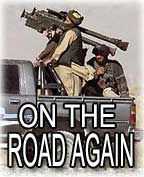 announced to the world that the United States had moved from a period of major combat activity to a period of stability and reconstruction in Afghanistan. The 'news' was gushingly reported by America's mainstream news media, e.g., Matt Kelley of the Associated Press and a favorite of the U.S. colonels at the Bagram Air Base.
announced to the world that the United States had moved from a period of major combat activity to a period of stability and reconstruction in Afghanistan. The 'news' was gushingly reported by America's mainstream news media, e.g., Matt Kelley of the Associated Press and a favorite of the U.S. colonels at the Bagram Air Base.
Fact: between June 1, 2003 - February 1, 2004, about 1,000 Afghans died in the continuing civil and guerrilla war, and in December 2003, U.S. forces carried out their largest deployment since December 2001 in Tora Bora.
On July 4, 2003, Arnold Schwarzenegger, paid a lightning visit to U.S. troops at Camp Victory off Highway Eight on the Baghdad airport road. While there, he announced,
"I play the Terminator, but you guys are the real terminators.
October 1, 2003
War and Modernity: Hard Times for Afghanistan's Kuchi Nomads
"Nomadic tribesman Haji Lawang saw the outline of the helicopter in the night sky and heard its roar as it streaked low over his three tents. A moment later, an explosion shook the ground and fire flew up from the desert about a mile away. The 50-year-old huddled with his two wives, four children, goats and camels and prayed his family wouldn't also be attacked. At dawn, he went out to investigate and found his neighbors' camp in ruins. Five women and four children were dead and six people were wounded, he said.
The U.S. military in Afghanistan said one of its helicopters attacked a tent the night of Sept. 18 in Naubahar district and killed two Taliban militants...The military initially said it was "highly confident" that only enemy fighters had been killed. Later, it said it was investigating reports of 'noncombatant casualties.'"
September 22, 2003
AfghaniScam: Livin' Large Inside Karzai's Reconstruction Bubble
In mid 2003, Domenic Medley, the British author of Kabul's first tourist guidebook since 1972, noted that aside from opium production, which has soared since the Taliban were tossed-out by U.S. bombs, serving foreigners is "the only real economy."
"Even though the British didn't call it a conquest, they were there in support of the shah - just as we're in support of Karzai - the Afghans realized this was a conquest, this was an occupation for all practical purposes....the thing that we have over the British is airpower. We won't have an army wiped out in the passes."
-- Afghanistan: A Military History from Alexander the Great to the Fall of the Taliban, Peter Tanner [De Capo Press, 2002]
In a forthcoming book, I argue that the descent from a predictable, frugal existence for the average Afghan before 1950, into an uncertain condition of modern impoverishment by the late 70s, has been exacerbated by periodic droughts and two decades of war.
August 14, 2003
Empty Hat: Foreign Investors Take A Pass On Karzai's Afghanistan
Since the "end" of the war in Afghanistan, no major foreign equity investment in either the goods 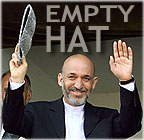 or the resources-producing sectors has been made, notwithstanding President Karzai's frantic travels abroad seeking to woo investors.
or the resources-producing sectors has been made, notwithstanding President Karzai's frantic travels abroad seeking to woo investors.
This contrasts sharply with Afghanistan under the Taliban [1996-2001], when both the giant U.S. oil firm UNOCAL, committed to building a trans-country gas pipeline and a private New Jersey-based enterprise, Telephone Systems International Inc., secured a license from the Taliban to set up an integrated, high-tech communications network costing $240 million.
June 16, 2003
Steel Rain: An analysis of Cluster Bomb use by the US in four recent campaigns
Terrorized Iraqi troops in 1991 called exploding US cluster bombs 'steel rain.'1 Such cluster munitions  can either be dropped from aircraft or fired inside artillery shells. The 'parent' bomb breaks apart as it nears the ground, spewing forth sub-munitions [or, bomblets]. The widely-used CBU-87 1,000 pound cluster bomb leaves a footprint of 458 meters; its wind-corrected version, the CBU-103, has a footprint of 183 meters. The footprint is measured by the area covered by bomblets. Each bomblet [BLU-107] in the CBU-87 injures people in a 152 meter radius. The bomblets drift down to earth with a small parachute. Though most explode upon impact, many do not. The reported 'dud rate' varies from eight – 22 percent.
can either be dropped from aircraft or fired inside artillery shells. The 'parent' bomb breaks apart as it nears the ground, spewing forth sub-munitions [or, bomblets]. The widely-used CBU-87 1,000 pound cluster bomb leaves a footprint of 458 meters; its wind-corrected version, the CBU-103, has a footprint of 183 meters. The footprint is measured by the area covered by bomblets. Each bomblet [BLU-107] in the CBU-87 injures people in a 152 meter radius. The bomblets drift down to earth with a small parachute. Though most explode upon impact, many do not. The reported 'dud rate' varies from eight – 22 percent.
April 8, 2003 --
When 'Precision' Bombing Really Isn't: The Evil, the Grotesque and the Official Lies
Since my previous essay , U.S.-U.K. bombing of Iraq has wreaked widespread carnage, utterly discrediting any notion of careful targeting and 'precision' strikes. 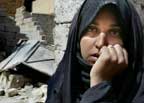 Through Friday, March 28th, U.S. bombs and missiles had killed about 450 Iraqi civilians, injuring at least 1,000. Well over 800 Iraqi civilians died under U.S. projectiles since the start of the war, that is, more than 50 per day. In the week since March 28th, U.S. "precision" projectiles have hit a vegetable market, numerous homes, markets, a hospital, a trade fair, telephone exchanges, a bus, farms, a grain silo, a street outside an emptying mosque, the lawn of a women's university, etc.
Through Friday, March 28th, U.S. bombs and missiles had killed about 450 Iraqi civilians, injuring at least 1,000. Well over 800 Iraqi civilians died under U.S. projectiles since the start of the war, that is, more than 50 per day. In the week since March 28th, U.S. "precision" projectiles have hit a vegetable market, numerous homes, markets, a hospital, a trade fair, telephone exchanges, a bus, farms, a grain silo, a street outside an emptying mosque, the lawn of a women's university, etc.
March 29, 2003 --
When 'Precision' Bombing Isn't
By now, those who wish to see may find all the signs of a repeat carnage - bombed buses, pulverized homes, an incinerated central market, flattened civilian structures [the tourist center  on the Tigris and the large museum in Tikrit], bombed neighborhoods, a bombed abandoned customs house, a girls' school leveled in Basra, scores of wounded civilians in hospitals, etc... The Pentagon, DoD, defense 'intellectuals', retired generals, and mainstream corporate press sign collective hosannas to 'precision' bombing which ring ever so hollow. Those who dared to look found the same for the U.S. attack upon Afghanistan [or the deadly night-time assault upon Panama in December 1989 which killed over 3,000 innocent civilians]. After a week of U.S.- U.K. attacks, Iraq's health minister reported on March 27th that 350 Iraqi civilians had died and 3,600 had been injured and the Pentagon reported that 600 Tomahawk cruise missiles, more than 4,300 "precision-guided" bombs had been dropped in the first 6 days of the war.
on the Tigris and the large museum in Tikrit], bombed neighborhoods, a bombed abandoned customs house, a girls' school leveled in Basra, scores of wounded civilians in hospitals, etc... The Pentagon, DoD, defense 'intellectuals', retired generals, and mainstream corporate press sign collective hosannas to 'precision' bombing which ring ever so hollow. Those who dared to look found the same for the U.S. attack upon Afghanistan [or the deadly night-time assault upon Panama in December 1989 which killed over 3,000 innocent civilians]. After a week of U.S.- U.K. attacks, Iraq's health minister reported on March 27th that 350 Iraqi civilians had died and 3,600 had been injured and the Pentagon reported that 600 Tomahawk cruise missiles, more than 4,300 "precision-guided" bombs had been dropped in the first 6 days of the war.
March 10, 2003 --
Et Plus Ca Change...Patterns of Death and Deceit in Afghanistan
In what must qualify as a stellar 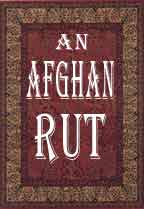 example of the old adage - those who fail to learn from history, are doomed to repeat it, a second time as farce - the U.S. military is once again romping around in the mountains and valleys of the upper Helmand Province, Afghanistan. Thirteen months ago, a large combined force of U.S. and Afghan troops was dispatched to Bahgran village, 250 kilometers northwest of Kandahar, "where intelligence reports said Mullah Omar had taken refuge with up to 1,500 of his religious militia's fighters." The expedition came up empty-handed. Mullah Omar outwitted hundreds of U.S. Special Forces, marines and surveillance aircraft, by reportedly speeding off into the hills on a motorcycle accompanied by four comrades!...
example of the old adage - those who fail to learn from history, are doomed to repeat it, a second time as farce - the U.S. military is once again romping around in the mountains and valleys of the upper Helmand Province, Afghanistan. Thirteen months ago, a large combined force of U.S. and Afghan troops was dispatched to Bahgran village, 250 kilometers northwest of Kandahar, "where intelligence reports said Mullah Omar had taken refuge with up to 1,500 of his religious militia's fighters." The expedition came up empty-handed. Mullah Omar outwitted hundreds of U.S. Special Forces, marines and surveillance aircraft, by reportedly speeding off into the hills on a motorcycle accompanied by four comrades!...
January 12, 2003 --
In December 2001, President Bush cited the Predator and Global Hawk drones -- which display the 'virtual reality' character of much of the U.S. military campaign in Afghanistan -- as examples of the kind of 'transformational' defense technologies whose development the Pentagon must accelerate. But in spite of the recent highly-publicized success of a Predator drone in blowing up a carload of alleged Al Qaeda operatives in Yemen, the system described by the Pentagon as "its eyes in the sky" has for the most part proven to be unreliable and laughably inaccurate.
This New Year was ushered in with yet another Predator falling from the sky into the remote village of Bashir Khan Jikhrani, a few miles from the U.S. air base in Jacobabad, Pakistan. Since military operations began in Afghanistan, U.S. forces have lost both of their Global Hawk unmanned aerial vehicle [UAV] drones as well as six of the smaller Predator RQ-1 unmanned drones -- that is, more than 12 percent of the total Predator fleet of 48 drones has been lost. In early February, the Center for Defense Intelligence reported,
November 28, 2002
Holiday Cheer, Pompoms, Bombs and Refugees: Thanksgiving 2001 in Afghanistan
The Pentagon has reported that 70 U.S. warplanes struck Afghanistan on Thanksgiving Day, November 22, 2001, using 50 carrier-based jets, 10 long-range bombers, and 10 land-based strike aircraft. The warplanes struck Taliban-held areas in the north, east and southern parts of the country, the Afghan Islamic Press reported at the time. The assault targeted Kunduz in the north, Kandahar in the south and Paktia in the east. U.S. fighter jets bombed the hills surrounding Kandahar, according to AIP. They also hit the Asman Zai district in Paktia Province, which was reported to have been a stronghold of Taliban minister Jalaladdin Haqqani. Three people in Kunduz were wounded by the continued airstrikes.
November 13, 2002
Uranium Wars: The Pentagon Steps Up its Use of Radioactive Munitions
Ever since the first Gulf War the U.S. military has increasingly used radioactive Depleted Uranium (DU) munitions. Against Iraq in 1991  they proved very effective at penetrating enemy armor (tanks). More recently in the Afghan campaign they were used extensively for destroying underground facilities and caves. The following table summarizes estimated usage of radioactive DU in three of America's recent wars. All these weapons will be almost certainly be heavily used should Gulf War II take place.
they proved very effective at penetrating enemy armor (tanks). More recently in the Afghan campaign they were used extensively for destroying underground facilities and caves. The following table summarizes estimated usage of radioactive DU in three of America's recent wars. All these weapons will be almost certainly be heavily used should Gulf War II take place.
October 31, 2002
U.S. Special Forces in Afghanistan: Vietnam Redux
"No one wants them there. They don't talk to anyone. They drive around maybe six or seven vehicles 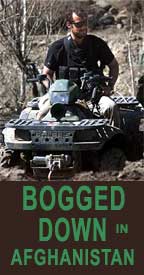 together in a convoy stopping to search houses. Everyone is afraid of them."
-- Abdul Ahmed Safi, official of the provincial Konar government.
together in a convoy stopping to search houses. Everyone is afraid of them."
-- Abdul Ahmed Safi, official of the provincial Konar government.
The Americans are no different from the Russians, one hears in Uruzgan and Kandahar.
U.S. Army Special Forces were first deployed in Afghanistan on October 19 in northern Afghanistan to serve primarily as spotters for U.S. bombing missions. On that same day, in a very embarrassing start to their Afghan ground campaign, the elite Delta Force suffered 12 casualties when ambushed by Taliban troops using machine guns and RPGs. The Delta team had landed by helicopter on Mullah Omar's summer retreat in the hills above Kandahar....
September 11, 2002
The Bombing of Afghanistan as Reflection of 9/11 and Different Valuations of Life
Robert Fisk, one of Britain's most distinguished foreign correspondents and a  person very familiar with central Asia, recently wrote in London's Independent:
person very familiar with central Asia, recently wrote in London's Independent:
"Why on earth are all my chums on CNN and Sky and the BBC rabbiting on about the "air campaign," coalition forces" and the "war on terror"? Do they think their viewers believe this twaddle? Certainly Muslims don't. In fact, you don't have to spend long in Pakistan to realize that the Pakistani press gives an infinitely more truthful and balanced account of the "war" - publishing work by local intellectuals, historians and opposition writers along with Taliban comments and pro-government statements as well as syndicated Western analyses - than the New York Times; and all this, remember, in a military dictatorship."
September 6, 2002
During late July-early August, three mentions of Afghan civilian casualties have been made. These are interesting less for their numerical accuracy 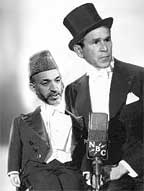 and more for their political content. The Bush Administration has persistently proclaimed the accuracy of U.S. bombing and the few though 'regrettable' civilian casualties. Disregarding widespread and increasing popular revulsion at home, the Karzai regime has also minimized these low numbers. Exactly three weeks after the deadly U.S. bombing attack of a wedding party in Uruzgan which was roundly criticized for relying upon flawed intelligence and exhibiting a 'shoot first and ask questions later' U.S. military mentality, the Karzai regime in Kabul told the BBC that fewer than 500 civilians were believed to have been killed in U.S. airstrikes during the entire Afghan campaign.
and more for their political content. The Bush Administration has persistently proclaimed the accuracy of U.S. bombing and the few though 'regrettable' civilian casualties. Disregarding widespread and increasing popular revulsion at home, the Karzai regime has also minimized these low numbers. Exactly three weeks after the deadly U.S. bombing attack of a wedding party in Uruzgan which was roundly criticized for relying upon flawed intelligence and exhibiting a 'shoot first and ask questions later' U.S. military mentality, the Karzai regime in Kabul told the BBC that fewer than 500 civilians were believed to have been killed in U.S. airstrikes during the entire Afghan campaign.
August 20, 2002
Dead Afghan Civilians: Disrobing the Non-Counters
 When the U.S. bombing started at 9 p.m. on October 7, 2001, an official 'counting of the dead' in Afghanistan was deemed largely unnecessary. The public was assured that U.S.- U.K. military planners would go to great lengths to avoid civilian casualties and the use of newer, precision-guided munitions would allow only killing the 'bad guys.' The Pentagon has steadfastly refused to deal with 'body counting', fearing an epiphany of the ghost of Vietnam.
When the U.S. bombing started at 9 p.m. on October 7, 2001, an official 'counting of the dead' in Afghanistan was deemed largely unnecessary. The public was assured that U.S.- U.K. military planners would go to great lengths to avoid civilian casualties and the use of newer, precision-guided munitions would allow only killing the 'bad guys.' The Pentagon has steadfastly refused to deal with 'body counting', fearing an epiphany of the ghost of Vietnam.
July 21, 2002
The Value of a Dead Afghan: Revealed and Relative
 By the extremely conservative standards of mainstream economics -- and many in Hamid Karzai's closest entourage are well-versed in such thinking having been employees of the World Bank and other pillars of international capitalism -- the compensation offered by the Karzai regime is paltry and insulting, even far below what should be given using the discounted future earnings approach.
By the extremely conservative standards of mainstream economics -- and many in Hamid Karzai's closest entourage are well-versed in such thinking having been employees of the World Bank and other pillars of international capitalism -- the compensation offered by the Karzai regime is paltry and insulting, even far below what should be given using the discounted future earnings approach.
July 8, 2002
Crashing the Wedding Party: Arrogance, Pentagon Speak and Spooky's Carnage
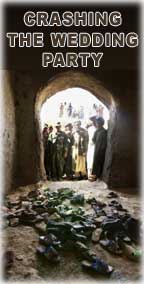 The attack upon Kakarak and three other nearby villages in the Deh Rawud district represents the most recent case justifying a perception that U.S. forces shoot first and ask questions later. And the attack upon Kakarak is far from being the deadliest to date in the U.S. bombing campaign -- raids upon Karam, Khanabad, Shah Agha and Kamo Ado killed many more innocent Afghan civilians -- facts which the mainstream American media mostly ignore.
The attack upon Kakarak and three other nearby villages in the Deh Rawud district represents the most recent case justifying a perception that U.S. forces shoot first and ask questions later. And the attack upon Kakarak is far from being the deadliest to date in the U.S. bombing campaign -- raids upon Karam, Khanabad, Shah Agha and Kamo Ado killed many more innocent Afghan civilians -- facts which the mainstream American media mostly ignore.
June 12, 2002
Locusts, Thin Mints and Pamela Anderson Descend Upon Afghanistan
 Juxtapositions can create discomfort, can jolt, can reveal. Here, the pre-modern real [basic food - vanishing wheat in Afghanistan] confronts the post-modern [images - an America of Thin Mints and Pamela Anderson]. The two are linked through the U.S. bombing campaign upon Afghanistan...[MORE]
Juxtapositions can create discomfort, can jolt, can reveal. Here, the pre-modern real [basic food - vanishing wheat in Afghanistan] confronts the post-modern [images - an America of Thin Mints and Pamela Anderson]. The two are linked through the U.S. bombing campaign upon Afghanistan...[MORE]
May 29, 2002
Karzai & Associates Budget:
Print Money [quietly] and Hope for Foreign Largesse
 "International donors have been assessing finance ministry procedures for handling the massive infusions of foreign aid, which the western-backed government needs to stay in power. But, perceptions of corruption have been a big obstacle, according to diplomats..." [MORE]
"International donors have been assessing finance ministry procedures for handling the massive infusions of foreign aid, which the western-backed government needs to stay in power. But, perceptions of corruption have been a big obstacle, according to diplomats..." [MORE]
May 12, 2002
Karzai & Associates' Trickle-Down Reconstruction
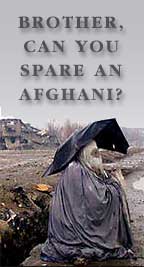 A bifurcated, externally driven, spatially segregated economic system, managed by a foreign 'trained' and foreign-backed elite is the image of tomorrow's 'successful' Afghanistan, representing the limit of development possibilities [and imagination] under the Intercontinental model of Karzai & Associates.
A bifurcated, externally driven, spatially segregated economic system, managed by a foreign 'trained' and foreign-backed elite is the image of tomorrow's 'successful' Afghanistan, representing the limit of development possibilities [and imagination] under the Intercontinental model of Karzai & Associates.
The Kabul Intercontinental Hotel serves as a powerful metaphor of this 'vision.' The 'vision' must be driven by certain hard facts: a 'demand profile' determined by social class and income realties; a particular 'insertion' of the Karzai regime in the international politico-economic order; and a specific emerging post-Taliban class and power structure...[MORE]
April 25, 2002
Postmodern Gestures of [in]Significance:
Proclaimed U.S. Air Supremacies Over Afghanistan
 "This is the ultimate post-modern war. The actual theatre of operations is the realm of symbols, and the target is people's minds—their very innate capacity to reason and question. In every modern war, propaganda has been deployed in the service of military objectives. In this war, military operations are not even in the service of propaganda: they are the propaganda."
"This is the ultimate post-modern war. The actual theatre of operations is the realm of symbols, and the target is people's minds—their very innate capacity to reason and question. In every modern war, propaganda has been deployed in the service of military objectives. In this war, military operations are not even in the service of propaganda: they are the propaganda."
On Tuesday, October 9, 2001, just two days after its attack upon Afghanistan had begun, the United States in a gesture of comical overkill proclaimed "air supremacy" over Afghanistan. Over what? The offensive capability of the Taliban Air Force comprised 15 aged fighter jets - five MIG-21MF 1960s era craft and 10 Sukhoi-22 fighter-bombers dating back to 1972.2 These planes when able to take to the air—scanty maintenance permitting—were flown by pilots from communist regime times of the 80s who were not even trained to fly at night...[MORE]
April 22, 2002
Bombing a Taliban Religious Ministry Building and Killing 30 Civilians in Proximity
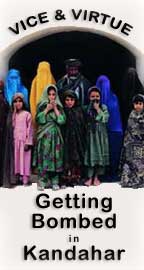 In the afternoon (4:30 P.M.) of October 17, U.S. war planes attacked downtown Kandahar city. The ostensible target was the headquarters of the Taliban's Ministry for the Protection of Virtue and Prevention of Vice (Ministry of Amr bil Marouf), located on the central city's Jada Road. Three 500 lb. JDAM bombs were dropped. The first hit an electrical substation located 100 yards away from the Ministry; the second bomb hit and damaged part of the Ministry building; and the third 'precision-guided' bomb struck residences and the like. Kandahar had been without water and electricity since October 15. The only electricity available is from diesel-run generators (but as of October 22, U.S.war planes began attacking trucks bringing-in fuel from Iran). An Indian correspondent writing for the Washington Post from Quetta in early November noted how U.S. bombing of non-military targets was deepening support for the Taliban in Kandahar.1 He also commented on life under U.S. bombs...[MORE]
In the afternoon (4:30 P.M.) of October 17, U.S. war planes attacked downtown Kandahar city. The ostensible target was the headquarters of the Taliban's Ministry for the Protection of Virtue and Prevention of Vice (Ministry of Amr bil Marouf), located on the central city's Jada Road. Three 500 lb. JDAM bombs were dropped. The first hit an electrical substation located 100 yards away from the Ministry; the second bomb hit and damaged part of the Ministry building; and the third 'precision-guided' bomb struck residences and the like. Kandahar had been without water and electricity since October 15. The only electricity available is from diesel-run generators (but as of October 22, U.S.war planes began attacking trucks bringing-in fuel from Iran). An Indian correspondent writing for the Washington Post from Quetta in early November noted how U.S. bombing of non-military targets was deepening support for the Taliban in Kandahar.1 He also commented on life under U.S. bombs...[MORE]
April 1, 2002
U.S. Bombing of Afghan Mosques
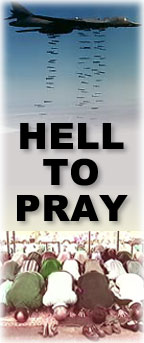 Between October 10 and December 20, 2001, U.S. bombs and missiles fell upon nine different mosques in Afghanistan, killing at least 120 innocent Afghan civilians. Mosques were hit in the provinces of Nangarhar, Kunduz, Herat, Kandahar and Paktia. The Pentagon admitted to only two 'mistakes'— one occuring on October 21 and another on November 16 in which two guided bombs went 'astray.' Witnesses in Jalalabad spoke of the Sultanpur mosque being hit during prayer time, on October 10, killing the 17 people inside.
Between October 10 and December 20, 2001, U.S. bombs and missiles fell upon nine different mosques in Afghanistan, killing at least 120 innocent Afghan civilians. Mosques were hit in the provinces of Nangarhar, Kunduz, Herat, Kandahar and Paktia. The Pentagon admitted to only two 'mistakes'— one occuring on October 21 and another on November 16 in which two guided bombs went 'astray.' Witnesses in Jalalabad spoke of the Sultanpur mosque being hit during prayer time, on October 10, killing the 17 people inside.
In the bombing of the Qalae Shater mosque, the bomb fell over 300 feet off target [a group of parked military vehicles]. In the attack on the agricultural village of Ishaq Sulaiman outside Herat, eight or nine bombs fell near a mosque, over half a kilometer from their target, killing 20 civilians and injuring another eight as they were emerging from early evening prayers. The mosque in the Kandahar suburb of Lungar was damaged in an attack by an AC- 130 gunship...[MORE]
March 16, 2002
Rubble Rousers:
U.S. Bombing and the Afghan Refugee Crisis
"Bombing Brings Flood of Refugees. Camps Set up as Thousands Flee U.S Attacks"
"One of UNICEF's young staff members in Herat witnessed a family of three children and their parents locked in an embrace and frozen to death."
"A dirty gray blanket on the hard desert is all that is home for Bibi Gul and her family in the new Afghanistan" [Christina Lamb, December 2001]
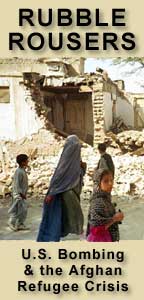 Last having eaten a meal begged more than a week ago, Bibi Gul accompanied by her five children, says, "the sky is my roof and the earth is my floor." On Friday morning [December 7], Bibi woke to find her two-year old son Tahir cold and stiff, frozen to death in the rain of western Afghanistan. Four days later, the Bush War for Civilization celebrated the 'liberation' of Kandahar city, whose fate would be returned to a particularly vicious, corrupt warlord and pedophile, Gul Agha...[MORE]
Last having eaten a meal begged more than a week ago, Bibi Gul accompanied by her five children, says, "the sky is my roof and the earth is my floor." On Friday morning [December 7], Bibi woke to find her two-year old son Tahir cold and stiff, frozen to death in the rain of western Afghanistan. Four days later, the Bush War for Civilization celebrated the 'liberation' of Kandahar city, whose fate would be returned to a particularly vicious, corrupt warlord and pedophile, Gul Agha...[MORE]
February 17, 2002
U.S. Media "Discovers" the Real, "Old" News
 Something both very interesting and revealing has recently occurred. The American mainstream media has "discovered" the civilian casualties in Afghanistan caused by the U.S. bombing campaign. The signal of this discovery was given by Ellen Knickmeyer of the Associated Press, who recently filed a dispatch headlined, "U.S. Attack Killed Children, Afghan Survivors Say."
Something both very interesting and revealing has recently occurred. The American mainstream media has "discovered" the civilian casualties in Afghanistan caused by the U.S. bombing campaign. The signal of this discovery was given by Ellen Knickmeyer of the Associated Press, who recently filed a dispatch headlined, "U.S. Attack Killed Children, Afghan Survivors Say."
For more than two months -- beginning with a radio interview on December 10th with Amy Goodman on Democracy Now -- I have been writing and speaking about the heavy civilian casualties caused by U.S. bombing attacks. But unlike the American mainstream press, I have argued that these innocent victims were primarily killed by particular U.S. bombing strategies, not by mistakes. The current media stories, however, still invoke the notion of bombing "errors," and more recently, faulty intelligence...[MORE]
February 1, 2002
Above the Law and Below Morality: Data on 11 Weeks of U.S. Cluster-Bombing of Afghanistan
['shining like a diamond,' death comes in a little yellow soda can]
"SOME OF the most savage weapons of modern warfare." That’s how one BBC journalist described cluster bombs, the U.S. military’s latest weapon of choice in Afghanistan. It's also deadly and cheap.
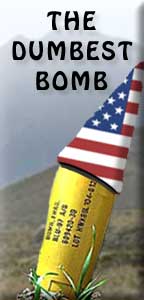 On October 10th, 2001, U.S. B-52s and B-1s began dropping deadly 1,000 lb. CBU-87 [$14,000 a bomb] and the wind-corrected CBU- 103 cluster [fragmentation] bombs upon "soft targets" [vehicles and people] in Afghanistan.
On October 10th, 2001, U.S. B-52s and B-1s began dropping deadly 1,000 lb. CBU-87 [$14,000 a bomb] and the wind-corrected CBU- 103 cluster [fragmentation] bombs upon "soft targets" [vehicles and people] in Afghanistan.
Eleven weeks later, U.S.planes had dropped 1,210 cluster bombs, each containing 202 BLU-97 bomblets. The British Halo Trust now estimates on the basis of groundwork in the vales of Afghanistan that 20% of the bomblets failed to explode, meaning 48,884 yellow soda-can sized, yellow-colored deadly sub- munitions now litter the villages, paths and fields of Afghanistan...[MORE]
January 18, 2002
The Failing Campaign to Kill Jalaluddin Haqqani
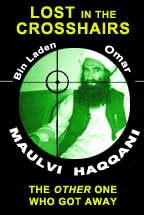 Chasing and bombing shadows? For two months now, the Pentagon has been carrying out a relentless bombing campaign seeking to kill Maulvi Jalaluddin Haqqani. The effort has failed, just as has the drive to apprehend Mullah Omar and Osama Bin Laden.
Chasing and bombing shadows? For two months now, the Pentagon has been carrying out a relentless bombing campaign seeking to kill Maulvi Jalaluddin Haqqani. The effort has failed, just as has the drive to apprehend Mullah Omar and Osama Bin Laden.
But who is Jalalludin Haqqani and why he is deserving of such Pentagon attention? With what effects?
A report filed by Reuters on October 9th, pondering the future of the Taliban, pointed to the prominence of Jalaluddin Haqqani:
"One of the main weathervanes will be Jalaluddin Haqqani, the most prominent Mujahideen commander from the Soviet war who sided with the Taliban when they made him minister for tribal affairs. Haqqani has returned to his stronghold in Khost, the eastern border area where Saudi-born militant Osama bin Laden reportedly had several training camps, and Afghan analysts are watching to see if he will turn coat and support Zahir Shah."
A veteran mujahideen and northern Pashtun, Haqqani rose to prominence as a military leader of the radical Islamic group and militia of Pashtun resistance to the Soviet-leaning communist government in Kabul, Hezb-e-Islami of Gulbuddin Hekmatyar, during the 1980s...[MORE]
March, 2002 [revised]
 What causes the documented high level of civilian casualties -- 3,000 - 3,400 civilian deaths -- in the U.S. air war upon Afghanistan? The explanation is the apparent willingness of U.S. military strategists to fire missiles into and drop bombs upon, heavily populated areas of Afghanistan. A legacy of the ten years of civil war during the 80s is that many military garrisons and facilities are located in urban areas where the Soviet-backed government had placed them since they could be better protected there from attacks by the rural mujahideen. Successor Afghan governments inherited these emplacements. To suggest that the Taliban used 'human shields' is more revealing of the historical amnesia and racism of those making such claims, than of Taliban deeds. Anti-aircraft emplacements will naturally be placed close by ministries, garrisons, communications facilities, etc.. A heavy bombing onslaught must necessarily result in substantial numbers of civilian casualties simply by virtue of proximity to 'military targets', a reality exacerbated by the admitted occasional poor targeting, human error, equipment malfunction, and the irresponsible use of out-dated Soviet maps. But, the critical element remains the very low value put upon Afghan civilian lives by U.S. military planners and the political elite, as clearly revealed by U.S. willingness to bomb heavily populated regions. Current Afghan civilian lives must and will be sacrificed in order to [possibly] protect future American lives. Actions speak, and words [can] obscure: the hollowness of pious pronouncements by Rumsfeld, Rice and the compliant corporate media about the great care taken to minimize collateral damage is clear for all to see. Other U.S. bombing targets hit are impossible to 'explain' in terms other than the U.S. seeking to inflict maximum pain upon Afghan society and perceived 'enemies': the targeted bombing of the Kajakai dam and other power stations, radio stations, the Kabul telephone exchange, the Al Jazeera Kabul office, trucks and buses filled with fleeing refugees, and the numerous attacks upon civilian trucks carrying fuel oil. Indeed, the bombing of Afghan civilian infrastructure parallels that of the Afghan civilian...[MORE]
What causes the documented high level of civilian casualties -- 3,000 - 3,400 civilian deaths -- in the U.S. air war upon Afghanistan? The explanation is the apparent willingness of U.S. military strategists to fire missiles into and drop bombs upon, heavily populated areas of Afghanistan. A legacy of the ten years of civil war during the 80s is that many military garrisons and facilities are located in urban areas where the Soviet-backed government had placed them since they could be better protected there from attacks by the rural mujahideen. Successor Afghan governments inherited these emplacements. To suggest that the Taliban used 'human shields' is more revealing of the historical amnesia and racism of those making such claims, than of Taliban deeds. Anti-aircraft emplacements will naturally be placed close by ministries, garrisons, communications facilities, etc.. A heavy bombing onslaught must necessarily result in substantial numbers of civilian casualties simply by virtue of proximity to 'military targets', a reality exacerbated by the admitted occasional poor targeting, human error, equipment malfunction, and the irresponsible use of out-dated Soviet maps. But, the critical element remains the very low value put upon Afghan civilian lives by U.S. military planners and the political elite, as clearly revealed by U.S. willingness to bomb heavily populated regions. Current Afghan civilian lives must and will be sacrificed in order to [possibly] protect future American lives. Actions speak, and words [can] obscure: the hollowness of pious pronouncements by Rumsfeld, Rice and the compliant corporate media about the great care taken to minimize collateral damage is clear for all to see. Other U.S. bombing targets hit are impossible to 'explain' in terms other than the U.S. seeking to inflict maximum pain upon Afghan society and perceived 'enemies': the targeted bombing of the Kajakai dam and other power stations, radio stations, the Kabul telephone exchange, the Al Jazeera Kabul office, trucks and buses filled with fleeing refugees, and the numerous attacks upon civilian trucks carrying fuel oil. Indeed, the bombing of Afghan civilian infrastructure parallels that of the Afghan civilian...[MORE]
December 29, 2001
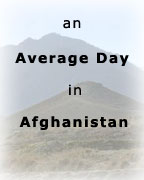 Between October 7 - December 6, U.S. aerial attacks on Afghanistan had killed an average of 62 innocent civilians a day. The bombing of a convoy of tribal elders during the night of December 20th is right on the trend line. This recent incident follows a pattern well-established over the past 10 weeks of U.S. bombing: First come the initial reports of civilian casualties from regional news agencies, then, denials by the Pentagon, and finally further details about the specifics of the attack, which get ignored by the U.S. military, political elite and domestic mainstream media, though are widely reported in the foreign press.
Between October 7 - December 6, U.S. aerial attacks on Afghanistan had killed an average of 62 innocent civilians a day. The bombing of a convoy of tribal elders during the night of December 20th is right on the trend line. This recent incident follows a pattern well-established over the past 10 weeks of U.S. bombing: First come the initial reports of civilian casualties from regional news agencies, then, denials by the Pentagon, and finally further details about the specifics of the attack, which get ignored by the U.S. military, political elite and domestic mainstream media, though are widely reported in the foreign press.